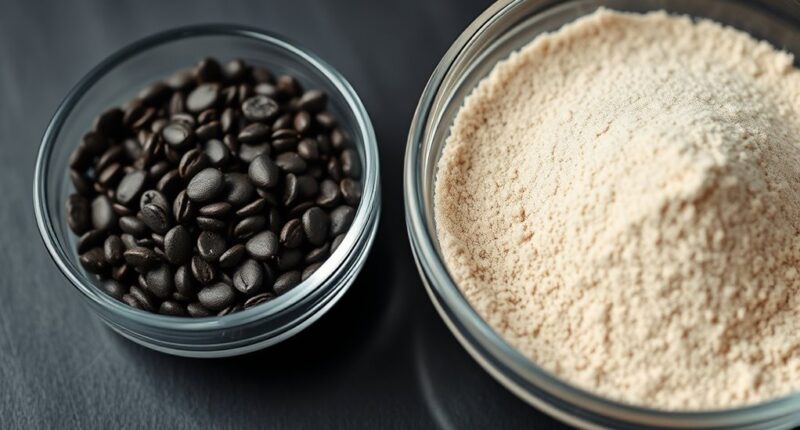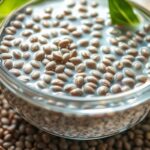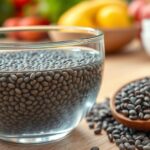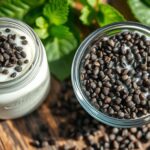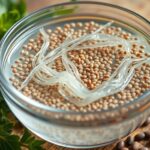If you want easier digestion, chia might be the better choice because it forms a gentle, gel-like texture that softens gradually and feeds beneficial gut bacteria. Psyllium creates a bulkier, faster-swelling fiber that can cause bloating or gas if you’re sensitive. Both can support digestive health, but your comfort depends on your tolerance and goals. Keep exploring to discover which fiber source suits your needs best.
Key Takeaways
- Chia seeds soften gradually and are gentler on sensitive stomachs, promoting easier digestion.
- Psyllium swells quickly, which may cause bloating or gas initially but effectively regulates bowel movements.
- Chia acts as a prebiotic, supporting gut bacteria and overall microbiome health, easing digestion over time.
- Psyllium’s bulk-forming properties are highly effective for constipation and irregularity, offering reliable digestive relief.
- Overall, chia offers smoother digestion for sensitive individuals, while psyllium provides more immediate bowel regulation benefits.
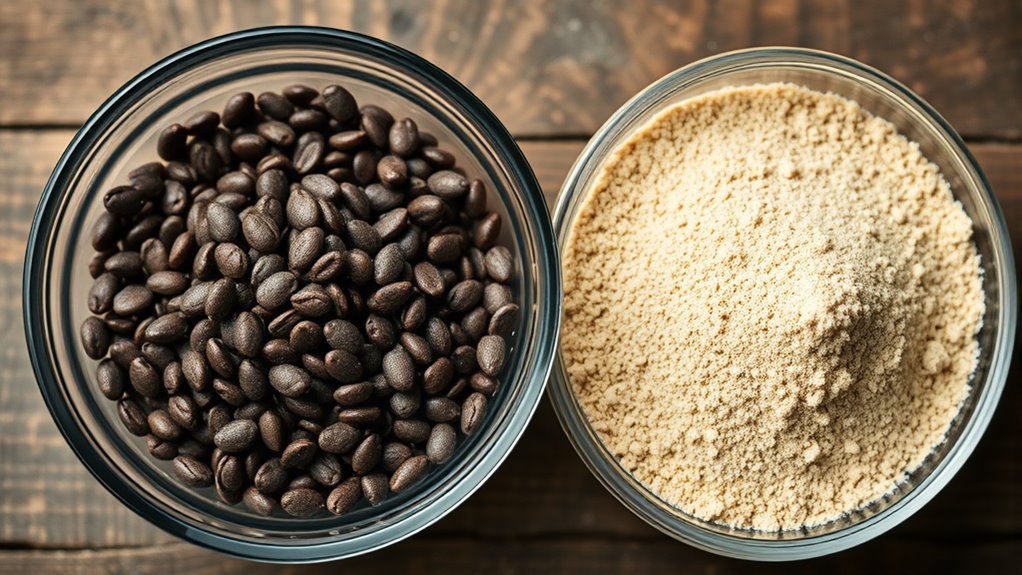
When choosing between chia and psyllium, understanding their differences can help you make an informed decision for your health. Both are popular fiber sources, but they interact with your digestive system in distinct ways. Chia seeds are rich in soluble fiber, which forms a gel-like substance when mixed with liquids. This gel slows down digestion and enhances fiber absorption, helping your body extract more nutrients from food. Psyllium, on the other hand, is almost pure soluble fiber derived from Plantago ovata husks. It swells markedly in water, creating bulk that stimulates bowel movements.
Your gut microbiome, the community of bacteria living in your intestines, responds differently to these fibers. Chia’s gel-like consistency serves as a prebiotic, feeding beneficial bacteria and promoting a healthy microbiome. This can lead to improved digestion and better nutrient absorption over time. Psyllium also supports gut health, but mainly by adding bulk to stool and aiding regularity. Its fermentation by gut bacteria is less pronounced than chia’s, so it may have a more direct effect on stool consistency rather than microbiome diversity.
Fiber absorption is another key factor. Chia seeds, thanks to their soluble fiber, not only slow digestion but also help stabilize blood sugar levels. Their gel traps carbohydrates, preventing rapid spikes in blood glucose after meals. Psyllium’s primary role is to increase stool weight and frequency, making it effective for constipation and diarrhea alike. Its bulk-forming properties draw water into the intestines, softening stool and facilitating smoother bowel movements.
In terms of digestive ease, chia tends to be gentler for those with sensitive stomachs because it softens in your gut gradually and supports a diverse microbiome. Psyllium’s rapid swelling can sometimes cause bloating or gas if your body isn’t used to high-fiber foods. However, it’s often recommended for specific digestive issues like irritable bowel syndrome (IBS) due to its effectiveness in regulating bowel movements.
Ultimately, your choice depends on your digestive needs. If you’re looking to support your gut bacteria and enjoy a versatile, nutrient-dense fiber, chia could be your go-to. If you need a straightforward solution for constipation or irregularity, psyllium’s bulk-forming action might be more suitable. Both fibers offer health benefits, but understanding how they interact with fiber absorption and your gut microbiome can help you select the best option for your digestive ease.
Frequently Asked Questions
Can Chia or Psyllium Help With Weight Loss?
You might find that chia or psyllium helps with weight loss by enhancing your fiber absorption and increasing satiety effects. Both fibers expand in your stomach, making you feel full longer and potentially reducing calorie intake. Chia seeds provide healthy fats and protein, while psyllium promotes regular digestion. Incorporating either into your diet could support your weight management goals, making it easier to stick to healthy eating habits.
Are Chia and Psyllium Suitable for Children?
Imagine you’re back in the days of the first printing press—bringing new info to light! When it comes to chia and psyllium for children, you should prioritize their pediatric safety and taste preferences. Both can be suitable if introduced carefully, but always consult a pediatrician first. Keep in mind, some kids might dislike the texture or flavor, so start with small amounts and observe their response.
How Do Allergies Affect Chia and Psyllium Consumption?
Allergies can markedly impact your chia and psyllium intake. If you have allergy symptoms, your immune response may trigger reactions like swelling or difficulty breathing when consuming these fibers. Chia and psyllium can cause allergic responses in sensitive individuals, so it’s essential to monitor for symptoms. Always check ingredient labels and consult a healthcare professional if you suspect an allergy, ensuring safe consumption and avoiding adverse immune responses.
Do Chia or Psyllium Impact Blood Sugar Levels?
Imagine a knight wielding a sword in a bustling market—your blood sugar impact is like his swift strike. Both chia and psyllium can influence your glycemic response, often stabilizing blood sugar levels. Chia seeds may cause a gentle rise, aiding in glucose control, while psyllium’s soluble fiber slows digestion, reducing spikes. Depending on your body’s response, choosing either can help manage blood sugar effectively.
Can Chia or Psyllium Be Used in Baking Recipes?
You can definitely use chia or psyllium in baking recipes as substitutions or for recipe modifications. Both act as natural binders and thickeners, making them great for gluten-free or high-fiber baked goods. Chia seeds can be ground into a gel, while psyllium husk provides a flexible, elastic texture. Just remember to adjust the liquid content accordingly, and you’ll enhance your recipes with added fiber and nutrition.
Conclusion
Ultimately, choosing between chia and psyllium depends on your digestion needs. Both offer unique benefits, so try them and see what works best for you. Remember, the proof is in the pudding—consistency is key. If one doesn’t sit right, switch it up. Your gut will thank you for listening and adapting. After all, a healthy gut is a happy gut, so trust your body and keep experimenting until you find your perfect fiber match.
